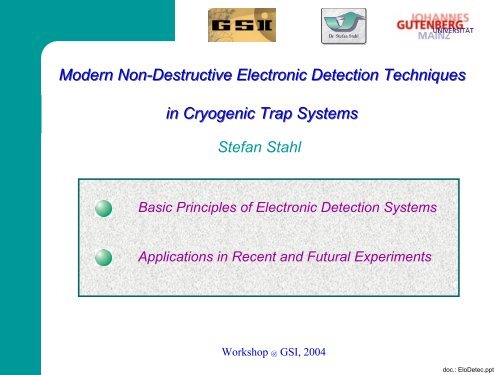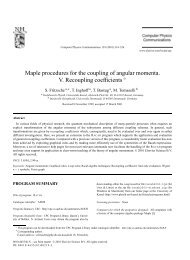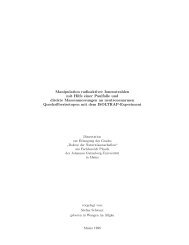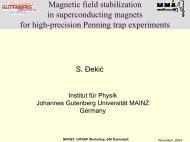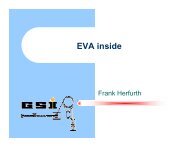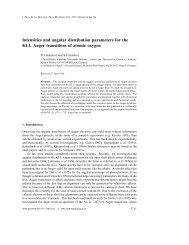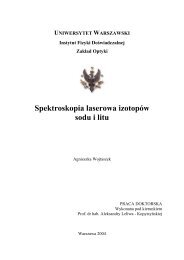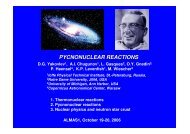Modern Non-Destructive Electronic Detection Techniques in ... - GSI
Modern Non-Destructive Electronic Detection Techniques in ... - GSI
Modern Non-Destructive Electronic Detection Techniques in ... - GSI
You also want an ePaper? Increase the reach of your titles
YUMPU automatically turns print PDFs into web optimized ePapers that Google loves.
<strong>Modern</strong> <strong>Non</strong>-<strong>Destructive</strong> <strong>Electronic</strong> <strong>Detection</strong> <strong>Techniques</strong><br />
<strong>in</strong> Cryogenic Trap Systems<br />
Stefan Stahl<br />
Basic Pr<strong>in</strong>ciples of <strong>Electronic</strong> <strong>Detection</strong> Systems<br />
Applications <strong>in</strong> Recent and Futural Experiments<br />
Workshop @ <strong>GSI</strong>, 2004<br />
doc.: EloDetec.ppt
Motivation:<br />
S. Stahl: <strong>Non</strong>destructive <strong>Electronic</strong> <strong>Detection</strong><br />
Why<br />
<strong>Non</strong>-destructive <strong>Detection</strong><br />
example TOF<br />
(time-of-flight,<br />
destructive)<br />
- advantage: s<strong>in</strong>gle particle sensitivity is possible, easy to use<br />
- disadvantage: removes ion out of your trap
Motivation:<br />
S. Stahl: <strong>Non</strong>destructive <strong>Electronic</strong> <strong>Detection</strong><br />
Why<br />
<strong>Non</strong>-destructive <strong>Detection</strong><br />
example TOF<br />
(time-of-flight,<br />
destructive)<br />
Laser-Spectrosc.<br />
(non-destructive)<br />
- advantage: few ... s<strong>in</strong>gle particle sensitivity possible<br />
- disadvantage: costly, only for very few species applicable,<br />
optical access needed
Motivation:<br />
S. Stahl: <strong>Non</strong>destructive <strong>Electronic</strong> <strong>Detection</strong><br />
Why<br />
<strong>Non</strong>-destructive <strong>Detection</strong><br />
Keep<strong>in</strong>g the particles <strong>in</strong>side your trap....<br />
• no need to load the trap aga<strong>in</strong><br />
(sav<strong>in</strong>g time, efforts & costs)<br />
• longer observation time<br />
(=> good for high precision experiments)<br />
• possibility to electronically cool them down to very low<br />
energies (~ few Milli-eV) <strong>in</strong> ~ 1sec. („resistive cool<strong>in</strong>g“)<br />
• tool for high precision experiments
S. Stahl: <strong>Non</strong>destructive <strong>Electronic</strong> <strong>Detection</strong><br />
How can we detect <br />
Make use of the fact, that Ions, Electrons, Protons, ....<br />
are electrically charged particles<br />
Every Mov<strong>in</strong>g Charge = Electrical Current<br />
=> you can measure it !
S. Stahl: <strong>Non</strong>destructive <strong>Electronic</strong> <strong>Detection</strong><br />
How can we detect <br />
Motion <strong>in</strong> a Penn<strong>in</strong>g Trap:<br />
ω c =<br />
qB<br />
m
S. Stahl: <strong>Non</strong>destructive <strong>Electronic</strong> <strong>Detection</strong><br />
How can we detect <br />
Motion <strong>in</strong> a Penn<strong>in</strong>g Trap:<br />
ω c =<br />
qB<br />
m
S. Stahl: <strong>Non</strong>destructive <strong>Electronic</strong> <strong>Detection</strong><br />
How can we detect <br />
Motion <strong>in</strong> a Penn<strong>in</strong>g Trap:<br />
ω c =<br />
qB<br />
m<br />
ω z = const.<br />
qU 0<br />
m<br />
ω - =<br />
U 0<br />
B r 0<br />
2
S. Stahl: <strong>Non</strong>destructive <strong>Electronic</strong> <strong>Detection</strong><br />
How can we detect <br />
Axial Motion:<br />
Z
S. Stahl: <strong>Non</strong>destructive <strong>Electronic</strong> <strong>Detection</strong><br />
How can we detect <br />
Axial Motion:<br />
<strong>in</strong>duced image currents<br />
Z<br />
<strong>in</strong>duced current:<br />
I eff = 1/√2 · r ion / D · ω ·q<br />
(Schottky et al. ...)<br />
still small:<br />
0.2pA eff
S. Stahl: <strong>Non</strong>destructive <strong>Electronic</strong> <strong>Detection</strong><br />
<strong>Detection</strong> of excited ions (few eV)<br />
- cyclotron motion<br />
x<br />
y
S. Stahl: <strong>Non</strong>destructive <strong>Electronic</strong> <strong>Detection</strong><br />
<strong>Detection</strong> of excited ions (few eV)<br />
- cyclotron motion<br />
x<br />
pickup-electrode<br />
y<br />
pickup-electrode
S. Stahl: <strong>Non</strong>destructive <strong>Electronic</strong> <strong>Detection</strong><br />
<strong>Detection</strong> of excited ions (few eV)<br />
- cyclotron motion<br />
x<br />
y<br />
„FT-ICR“<br />
fourier-transform-ion cyclotron resonance<br />
„FT-ICR-cells“<br />
used <strong>in</strong> chemistry/biology<br />
m/q-resol. ~10 5 ...10 6<br />
still: s<strong>in</strong>gle ion detection<br />
not possible
Sensitivity Improvement:<br />
Resonant <strong>in</strong>stead of broadband detection<br />
I<br />
S. Stahl: <strong>Non</strong>destructive <strong>Electronic</strong> <strong>Detection</strong><br />
measured signal:<br />
U = Z · I<br />
Z LC = Q LC ·|Z C,parasitic |<br />
ω ion = ω LC = 1/√(LC)<br />
broadband<br />
(given : r ion<br />
, D)<br />
resonant<br />
enhancement factor<br />
~100 (T=300K)<br />
~2000 (T = 4K)<br />
⇒cryogenic<br />
components<br />
this idea applies for axial detection as well as for FT-ICR !
S. Stahl: <strong>Non</strong>destructive <strong>Electronic</strong> <strong>Detection</strong><br />
Examples of high-Q-coils:<br />
500kHz-coil<br />
for FT-ICR detection of heavy masses<br />
(Shiptrap / MATS)<br />
NbTi wire on Teflon<br />
30MHz-coil<br />
for FT-ICR of hydrogenlike ions<br />
(g-factor, Ma<strong>in</strong>z)<br />
gold plated copper
Applications and Examples<br />
of non-destructive electronic detection schemes<br />
S. Stahl: <strong>Non</strong>destructive <strong>Electronic</strong> <strong>Detection</strong><br />
g-factor measurements: neccessity to know the<br />
magnetic field strength B 12<br />
C 5+<br />
FT-ICR-signal (resonant):<br />
FWHM of 6·10 -10 ,<br />
measurement time: 120sec<br />
(=Fourier-Limit)<br />
E k<strong>in</strong> ~ 1eV<br />
qB<br />
ω c = = ω + + ω<br />
m<br />
−<br />
Limitation: B-field drifts<br />
⇒short measurement times
S. Stahl: <strong>Non</strong>destructive <strong>Electronic</strong> <strong>Detection</strong><br />
Count<strong>in</strong>g s<strong>in</strong>gle ions...<br />
how many ions are<br />
<strong>in</strong>side the trap<br />
=> just count them!<br />
without magnetron center<strong>in</strong>g<br />
ions show a considerable<br />
frequency spread
S. Stahl: <strong>Non</strong>destructive <strong>Electronic</strong> <strong>Detection</strong><br />
Resistive Cool<strong>in</strong>g<br />
<strong>in</strong>duced current creates thermal energy <strong>in</strong> R => dissipative effect,<br />
=> exponential decay of amplitude<br />
τ =<br />
R =<br />
m · D²<br />
q² · R<br />
Q<br />
ω ·C<br />
ion D<br />
12<br />
C 5+ 5.5mm 23ms<br />
Protons, ‘‘’<br />
49ms<br />
131<br />
Xe 44+ , 20mm 3.3ms<br />
e - , e + , 0.7mm 10.9µs<br />
for Q = 2000, f = 0.4MHz, C = 20pF (except e - , e + )<br />
τ
S. Stahl: <strong>Non</strong>destructive <strong>Electronic</strong> <strong>Detection</strong><br />
<strong>Detection</strong> of cold particles:<br />
⇒possibility to<br />
detect cold ions
Bolometric <strong>Detection</strong><br />
S. Stahl: <strong>Non</strong>destructive <strong>Electronic</strong> <strong>Detection</strong><br />
of s<strong>in</strong>gle cold ions
S. Stahl: <strong>Non</strong>destructive <strong>Electronic</strong> <strong>Detection</strong><br />
Mass Spectra (ramp<strong>in</strong>g method)<br />
(Rett<strong>in</strong>ghaus at al. 1967)<br />
Axial Motion:<br />
ω z ~ (qU 0 /m) 1/2<br />
Ion Signal <strong>in</strong><br />
Barium-Penn<strong>in</strong>g Trap,<br />
(Ma<strong>in</strong>z)<br />
@ 300K Q LC = 250<br />
=> simple and cost effective method
S. Stahl: <strong>Non</strong>destructive <strong>Electronic</strong> <strong>Detection</strong><br />
Determ<strong>in</strong>ation of the free Proton<br />
Magnetic Moment<br />
µ p<br />
µ N<br />
=<br />
g p<br />
⋅<br />
s<br />
h<br />
• first direct high precision measurement of a free<br />
nuclear particles magnetic moment<br />
• proton / antiproton comparison,<br />
matter / antimatter symmetry (CPT-Test)
S. Stahl: <strong>Non</strong>destructive <strong>Electronic</strong> <strong>Detection</strong><br />
Application of Cryogenic <strong>Electronic</strong>s<br />
at the Proton Trap:<br />
-calibration of B (magnetic field)<br />
-determ<strong>in</strong>ation of the ω z<br />
, ω -<br />
-cool<strong>in</strong>g the degrees of freedom down to 4K<br />
by resistive cool<strong>in</strong>g (and magnetron center<strong>in</strong>g)<br />
-detection of the sp<strong>in</strong> direction<br />
not quite easy...
Measurement Pr<strong>in</strong>ciple:<br />
Cont<strong>in</strong>ious Stern-Gerlach Effect<br />
S. Stahl: <strong>Non</strong>destructive <strong>Electronic</strong> <strong>Detection</strong><br />
Magnetic Bottle <strong>in</strong> „Double Trap“:<br />
electrical<br />
potential<br />
up<br />
down<br />
Axial Frequency<br />
depends on Sp<strong>in</strong> State!<br />
∆ω z = µ P ·B 2 /(m·ω z )<br />
Problem: µ P is very small<br />
⇒∆ω z frequency jump only<br />
few mHz <strong>in</strong> a „normal“ Trap
Motional Phase <strong>Detection</strong> makes very small<br />
frequency changes visible<br />
S. Stahl: <strong>Non</strong>destructive <strong>Electronic</strong> <strong>Detection</strong><br />
one order of mag. improvement expected:<br />
e.g. 45° phase difference after 1s => 125mHz
Setup Details<br />
Proton Experiment<br />
S. Stahl: <strong>Non</strong>destructive <strong>Electronic</strong> <strong>Detection</strong>
Hav<strong>in</strong>g a glance at<br />
cryogenic setups....<br />
vertical 4Kdewar<br />
setup<br />
(g-factor, Ma<strong>in</strong>z)<br />
S. Stahl: <strong>Non</strong>destructive <strong>Electronic</strong> <strong>Detection</strong><br />
4K-multistage<br />
shield<strong>in</strong>g<br />
(g-factor, Ma<strong>in</strong>z)<br />
g-factor trap<br />
4K-electronics section<br />
4K-axial<br />
amplifier<br />
4K-broadband<br />
FT-ICR amplifier<br />
( Ma<strong>in</strong>z 2004 )
S. Stahl: <strong>Non</strong>destructive <strong>Electronic</strong> <strong>Detection</strong><br />
Conclusion<br />
<strong>Modern</strong> non-destructive electronic detection pr<strong>in</strong>ciples<br />
open up a variety of possibilities<br />
• to detect ion clouds at roomtemperature <strong>in</strong> a quick<br />
and cost-effective way<br />
• at 4K to detect s<strong>in</strong>gle particles and cool them to<br />
sub milli-eV level with superconduct<strong>in</strong>g elements<br />
• can be used <strong>in</strong> high precision experiments like<br />
- g-factor measurements (HCI‘s, Proton, Anti-p)<br />
- ultra-high precision mass-determ<strong>in</strong>ations
Outlook:<br />
recent and futural experiments us<strong>in</strong>g<br />
cryogenic electronic detection systems<br />
S. Stahl: <strong>Non</strong>destructive <strong>Electronic</strong> <strong>Detection</strong><br />
• High precision g-factor determ<strong>in</strong>ation on<br />
medium-heavy HCI Ca 17+ , Ca 19+<br />
<strong>in</strong>clud<strong>in</strong>g 3 superconduct<strong>in</strong>g circuits, resonant FT-ICR<br />
and cryogenic broadband FT-ICR<br />
• Proton g-factor determ<strong>in</strong>ation<br />
• Hitrap Cooler Trap<br />
cool<strong>in</strong>g down HCI by collision and by resistive cool<strong>in</strong>g,<br />
• Quele-Trap for Quantum Comput<strong>in</strong>g<br />
• Broadband FT-ICR for KATRIN (Karlsruhe)<br />
• FT-ICR ultrahigh precision mass determ<strong>in</strong>ation<br />
(MATS, Ma<strong>in</strong>z)<br />
• and....
S. Stahl: <strong>Non</strong>destructive <strong>Electronic</strong> <strong>Detection</strong><br />
many thanks to the teams <strong>in</strong> Ma<strong>in</strong>z and <strong>GSI</strong> (Shiptrap, MATS, g-Factor)<br />
Thanks for your attention!


